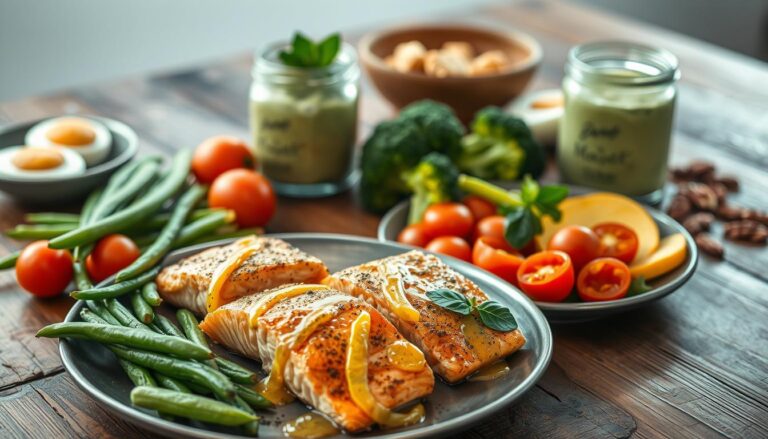Lobster Bisque: A Trendy Lunch Recipe You’ll Love

Lobster bisque is the epitome of indulgence, combining rich flavours and creamy textures into a bowl of pure comfort. Whether you’re hosting a lunch for friends or treating yourself to a luxurious midday meal, this easy lobster bisque recipe will become your go-to dish. With its velvety consistency and delicate seafood notes, it’s no wonder that lobster bisque has earned its place as a timeless classic in the culinary world.
In this post, we’ll guide you step-by-step through making a creamy lobster bisque that’s both simple and sophisticated. From selecting the best ingredients to mastering techniques like simmering and thickening, you’ll learn everything you need to create a restaurant-quality soup at home. Plus, we’ll include tips on how to elevate your presentation with garnishes and pairings. Let’s dive in!
Before we dive into the step-by-step instructions for making this easy lobster bisque, let’s talk about the essential tools you’ll need to ensure success. From simmering to blending, these gadgets will simplify the process and help you achieve restaurant-quality results
Table of Contents
Essential Tools for Making Lobster Bisque Like a Pro
To create the perfect lobster bisque, having the right tools on hand can make all the difference. Here’s a list of must-have kitchen gadgets that will simplify the process and ensure professional-quality results:
1. Dutch Oven
A reliable Dutch oven is essential for simmering your lobster bisque to perfection. Its thick walls distribute heat evenly, preventing hot spots that could burn delicate ingredients like cream or lobster meat.
Recommendation: Le Creuset Signature Enameled Cast Iron Dutch Oven
Mention in Post: “For best results, use a heavy-bottomed Dutch oven like this one from Le Creuset. It ensures even heating and helps develop those rich flavours we’re aiming for.”
2. Immersion Blender
An immersion blender is a game-changer when it comes to achieving that silky-smooth texture in your bisque. Unlike traditional blenders, it allows you to blend directly in the pot, minimizing mess and saving time.
Recommendation: Cuisinart Smart Stick Hand Blender
Mention in Post: “Skip the hassle of transferring hot soup to a countertop blender—this immersion blender makes blending safe, quick, and effortless.
Lobster Bisque Recipe: The Ultimate Guide
Before we get started, let’s talk about what makes a lobster bisque so special. This French-inspired dish relies heavily on fresh lobster meat, flavorful lobster stock, and aromatic vegetables to create a base bursting with umami goodness. Once blended and enriched with heavy cream, the result is a decadent soup that’s smooth, creamy, and utterly irresistible.
Ingredients You’ll Need
To make this easy lobster bisque, gather the following:
- 2 lobster tails (or pre-cooked lobster meat)
- 4 cups of homemade or store-bought lobster stock
- 1 cup of dry white wine
- 1 tablespoon of tomato paste
- 2 stalks of celery, diced
- 1 medium onion, finely chopped
- 2 tablespoons of butter
- 2 tablespoons of all-purpose flour (to thicken the soup)
- 1 cup of heavy cream
- 2 tablespoons of sherry (optional but recommended)
- Salt and pepper for seasoning
- Fresh herbs (like parsley or chives) for garnish
Make Lobster Bisque: Step-by-Step Instructions
Cook Lobster
If you’re using fresh lobster tails, start by preparing them. Using kitchen shears, cut through the top shell to expose the meat. Place the tails in boiling water for about 2 minutes, just until they turn bright red. Remove them from the pot, let them cool slightly, and then extract the lobster meat from the shell. Set aside the meat, as it will be added back into the soup later. Don’t discard the lobster shell, though—it’s essential for creating a flavorful lobster stock.
If you’re working with fresh lobster tails, a pair of sturdy kitchen shears is indispensable for slicing through tough shells cleanly. These Kershaw Multitasker Shears are my go-to—they’re durable, ergonomic, and make quick work of prepping lobster meat:
3. Kitchen Shears
When working with lobster tails, sharp kitchen shears are indispensable for cutting through tough shells cleanly and efficiently. They’re also great for trimming herbs or garnishing your finished dish.
Recommendation: Kershaw Multitasker Kitchen Shears
Mention in Post: “These sturdy kitchen shears make quick work of cracking open lobster shells, ensuring you extract every bit of delicious meat.”
4. Fine Mesh Strainer
After simmering your lobster stock, straining out shell fragments and impurities is key to achieving a clear, refined broth. A fine mesh strainer does this job beautifully while retaining maximum flavour.
Recommendation: OXO Good Grips Fine Mesh Strainer
Mention in Post: “For a perfectly smooth lobster stock, strain it through a fine mesh sieve like this one from OXO. It catches even the tiniest bits of shell debris.
Simmer the Base
In a large Dutch oven, melt the butter over medium-low heat. Add the diced celery and onions, stirring occasionally until softened. Stir in the tomato paste and cook for another minute to deepen the flavour. Sprinkle the flour over the mixture, continuing to stir to avoid lumps. Gradually pour in the white wine, allowing it to reduce slightly before adding the lobster stock.
Place the reserved lobster shells into the pot to infuse even more flavour into the broth. Bring the mixture to a boil, then lower the heat and allow it to simmer for 20–30 minutes.
To simmer your flavorful base, a heavy-bottomed Dutch oven like this one from Le Creuset is ideal. Its cast iron construction ensures even heating, preventing scorching and allowing flavours to meld beautifully:
5. Silicone Spatula
A high-quality silicone spatula is ideal for scraping down the sides of pots and bowls, ensuring no precious bisque goes to waste. Plus, its heat-resistant design makes it safe for stovetop use.
Recommendation: Di Oro Living Premium Silicone Spatula
Mention in Post: “This silicone spatula is a lifesaver when folding in cooked lobster meat or scraping the last drops of creamy goodness from your pot.
6. Digital Kitchen Scale
Precision matters when measuring ingredients like flour (for thickening) or lobster meat. A digital kitchen scale ensures accuracy, which is especially important if you’re scaling the recipe up or down.
Recommendation: Etekcity Digital Kitchen Scale
Mention in Post: “If you want restaurant-worthy consistency, invest in a digital scale to measure your ingredients accurately—it’s worth every penny!
Blend and Thicken the Soup
Once the base has simmered, remove the lobster shells and discard them. Carefully transfer the liquid to a blender and blend until smooth. Return the blended mixture to the pot and stir in the heavy cream. For an extra layer of complexity, add a splash of sherry. Continue to simmer the soup while stirring occasionally, ensuring it doesn’t boil too vigorously.
Finally, shred the cooked lobster meat into bite-sized pieces and gently fold it into the soup. Season with salt and pepper to taste.
For an elegant presentation, serve your bisque with a sleek ladle like the OXO Good Grips Stainless Steel Ladle—it’s functional and stylish. And if you have leftovers, store them in airtight glass containers like these Pyrex Simply Store sets to keep the flavours intact
7. Chef’s Knife & Cutting Board Set
From chopping celery and onions to slicing fresh herbs for garnish, a sharp chef’s knife paired with a durable cutting board is indispensable in any kitchen.
Recommendation: Victorinox Fibrox Pro Chef’s Knife
Mention in Post: “This combo of a razor-sharp chef’s knife and sturdy bamboo cutting board makes prepping vegetables and herbs a breeze.”
8. Ladle
Serving your lobster bisque elegantly requires a good ladle. Look for one with a comfortable grip and a deep bowl to prevent spills.
Recommendation: OXO Good Grips Stainless Steel Ladle
Mention in Post: “Serve your bisque with style using a sleek ladle like this one—it’s functional, durable, and looks great at the table.”
Creamy Lobster Bisque: Tips for Success
Creating the perfect bisque recipe requires attention to detail. Here are some recipe tips to ensure your lobster bisque turns out perfectly every time:
- Use Fresh Ingredients: High-quality lobster meat and homemade lobster stock can make all the difference in flavour. If you don’t have time to make your stock, opt for a premium store-bought version.
- Don’t Skip the Sherry: While optional, sherry adds a subtle nuttiness that enhances the overall depth of the soup.
- Blend Carefully: To achieve a silky texture, blend the soup thoroughly. Be cautious when blending hot liquids—do it in batches if necessary.
- Thicken Wisely: Use flour sparingly to thicken the soup without overpowering its natural flavours.
Delicious Lobster Recipes to Try
If you love this lobster bisque, why not explore other delicious lobster recipes? Here are a few ideas to inspire your next seafood adventure:
- Lobster Mac and Cheese: Combine creamy pasta with chunks of tender lobster meat for a comforting twist on a classic favourite.
- Grilled Lobster Tails: Brushed with garlic butter and grilled to perfection, these are perfect for summer dinners.
- Lobster Risotto: A creamy Italian dish featuring Arborio rice, lobster stock, and succulent lobster chunks.
Best Lobster Bisque vs. Other Variations
Let’s take a closer look at how our easy lobster bisque stacks up against other popular variations. Below is a comparison table highlighting key differences:
| Feature | Easy Lobster Bisque | Classic Lobster Bisque | Creamy Lobster Bisque |
|---|---|---|---|
| Cooking Time | ~45 minutes | ~1 hour | ~1 hour 15 minutes |
| Key Ingredient | Fresh lobster meat | Whole live lobster | Pre-cooked lobster meat |
| Flavor Profile | Light and balanced | Rich and intense | Ultra-creamy |
| Difficulty Level | Beginner-friendly | Intermediate | Advanced |
| Garnish Suggestions | Parsley, chives | Croutons, lemon zest | Truffle oil, caviar |
As you can see, each variation offers something unique. Our easy lobster bisque strikes a balance between simplicity and elegance, making it ideal for home cooks who want impressive results without spending hours in the kitchen.
How Do I Make a Lobster Bisque?

The process may seem daunting at first, but breaking it down into manageable steps makes it approachable. Start by focusing on the basics: cooking the lobster, building a flavorful base, and achieving the right consistency. Remember, practice makes perfect! The more you experiment with different seasonings and techniques, the better your lobster bisque will become.
For those looking to expand their repertoire, consider trying alternative methods like roasting the lobster shells before simmering them for an even deeper flavor. Or, swap out the heavy cream for coconut milk for a dairy-free option.
The Art of Making Lobster Bisque: Mastering the Details
While the recipe itself is straightforward, some nuances can elevate your lobster bisque from good to extraordinary. Here’s how to refine each step and truly master the craft of making this iconic dish.
Choosing the Right Lobster Meat
When it comes to selecting lobster meat, freshness is paramount. If you’re using live lobsters, opt for those that feel heavy for their size—this indicates they have plenty of meat inside. Alternatively, if you’re short on time or prefer convenience, high-quality pre-cooked lobster meat works beautifully too. Look for sustainably sourced options whenever possible.
If you decide to use lobster tails, choose ones with vibrant shells and firm flesh. A 6-ounce tail per person is usually sufficient for a generous serving of bisque. Remember, the better the quality of your ingredients, the more flavorful your final product will be.
Building Flavor with Lobster Stock
The foundation of any great bisque recipe lies in its stock. While store-bought versions are convenient, nothing beats homemade lobster stock. To make your own, save the leftover lobster shells after extracting the meat. Roast them in the oven at 400°F (200°C) for about 15 minutes until fragrant and slightly browned. This caramelization process enhances the depth of flavour.
Next, simmer the roasted shells with aromatics like garlic, bay leaves, thyme, and peppercorns in water for 45–60 minutes. Strain the liquid, and voilà—you’ve got a rich, flavorful base for your bisque. If you don’t have time to make stock from scratch, look for premium seafood stocks available at most grocery stores.
Thickening Techniques for Perfect Consistency
Achieving the ideal thickness for your lobster bisque is crucial. Too thin, and it won’t feel indulgent; too thick, and it risks becoming gluey. There are several methods to thicken your soup:
- Roux Method: As outlined in the recipe, combining butter and flour creates a roux that acts as a thickener when incorporated into the broth.
- Pureed Vegetables: Blend cooked vegetables like carrots or potatoes directly into the soup for the added body without altering the flavour profile significantly.
- Reduction: Simmer the broth uncovered for an extended period to allow excess liquid to evaporate naturally, concentrating the flavours and thickening the soup.
Experiment with these techniques to find what works best for your taste preferences.
Recipe Tips for Elevating Your Lobster Bisque
Here are some insider tricks to take your lobster bisque to the next level:
Use Sherry Wisely
Adding a splash of sherry near the end of cooking not only enhances the complexity of the dish but also balances the richness of the cream. Opt for dry sherry rather than sweet varieties to maintain the savoury nature of the soup.
Season Thoughtfully
Seasoning is where many home cooks falter. Start with minimal salt since the lobster stock and other ingredients may already contain sodium. Taste frequently throughout the cooking process and adjust accordingly. Freshly ground black pepper, a pinch of cayenne, or a squeeze of lemon juice can brighten up the flavours.
Garnish Creatively
Presentation matters! Finish your lobster bisque with a sprinkle of fresh herbs like parsley or chives for colour and freshness. For a touch of luxury, drizzle a bit of truffle oil or top with a dollop of crème fraîche. Crispy croutons or a swirl of chilli-infused oil can add texture and contrast.
Creative Ways to Serve Lobster Bisque
While lobster bisque shines as a standalone dish, pairing it with complementary sides or incorporating it into larger meals can create memorable dining experiences.
Pair It with Bread
A crusty baguette or warm dinner rolls are classic accompaniments to bisque soup . For something more elevated, try garlic bread or cheesy crostini topped with grated Parmesan.
Incorporate It Into Other Dishes
Transform your leftover lobster bisque into new creations:
- Lobster Bisque Risotto: Use the bisque as the liquid base for creamy risotto instead of traditional broth.
- Seafood Chowder: Combine the bisque with diced potatoes, corn, and additional seafood like shrimp or scallops for a hearty chowder.
- Pasta Sauce: Toss cooked pasta with reduced bisque for a decadent lobster Alfredo-inspired sauce.
Make It a Complete Meal
Serve your lobster bisque alongside a light salad or steamed vegetables for a well-rounded meal. A glass of chilled white wine pairs wonderfully with the richness of the soup.
Common Mistakes to Avoid When Making Lobster Bisque
Even experienced cooks can stumble when preparing lobster bisque. Here are some common pitfalls and how to avoid them:
Overcooking the Lobster
Overcooked lobster meat becomes rubbery and loses its delicate sweetness. Always cook the lobster just until opaque, whether boiling or grilling. If adding cooked lobster back into the soup, do so during the last few minutes of simmering to prevent overcooking.
Neglecting the Aromatics
The aromatic vegetables (onions, celery, etc.) provide the backbone of flavor. Don’t rush this step—allow them to soften and develop a golden hue before proceeding.
Skipping the Blender
Blending the soup ensures a velvety texture. If you skip this step, the bisque may lack the smooth consistency that defines it. Invest in a high-quality blender or immersion blender for best results.
Why Lobster Bisque Is Trendier Than Ever
In recent years, lobster bisque has seen a resurgence in popularity, thanks in part to social media platforms showcasing beautifully plated dishes. Its luxurious reputation makes it a favourite among food bloggers and influencers alike. Plus, with modern kitchen tools like Instant Pots and blenders, preparing this once-daunting dish has never been easier.
Restaurants have also embraced the trend by offering unique twists on traditional recipes. Some chefs incorporate exotic spices, while others experiment with plant-based alternatives to cater to vegan diners. No matter the variation, lobster bisque remains a timeless symbol of elegance and indulgence.
Conclusion: Dive Into the World of Lobster Bisque
There’s no denying the allure of creamy lobster bisque. Whether you’re hosting a dinner party or simply craving a comforting bowl of soup, this easy lobster bisque recipe delivers big on flavour without requiring advanced culinary skills. With its luscious texture, balanced seasoning, and undeniable charm, it’s no wonder that lobster bisque continues to captivate food lovers worldwide.
So why wait? Gather your ingredients, follow our detailed guide, and embark on a delicious journey into the heart of seafood cuisine. Once you’ve mastered this recipe, don’t hesitate to share your creations with friends and family—or snap a photo and post it online. After all, everyone deserves a taste of luxury now and then!
Finally, don’t underestimate the power of good tools in the kitchen. Whether it’s a trusty Dutch oven, a versatile immersion blender, or precision tools like a digital scale, having the right equipment makes all the difference when crafting a show-stopping lobster bisque. Check out the links above to explore these products further—they’re tried-and-true favourites among home cooks
9. Thermometer
Maintaining the correct temperature is crucial when simmering soups. A digital instant-read thermometer ensures your lobster bisque stays within the optimal range for flavour development.
Recommendation: ThermoPro TP-19 Waterproof Digital Thermometer
Mention in Post: “Keep your bisque at just the right simmer with a trusty thermometer . This model gives accurate readings in seconds, so you never overheat your soup.”
10. Storage Containers
Leftover lobster bisque deserves proper storage. Opt for airtight glass containers to preserve freshness and reheat easily without absorbing odors.
Recommendation: Pyrex Simply Store Glass Food Storage Set
Mention in Post: “Store leftovers in these stackable glass containers —they’re microwave-safe, eco-friendly, and keep your bisque tasting fresh for days
Final Thoughts: Why You’ll Love This Recipe
There’s nothing quite like the satisfaction of serving a steaming bowl of creamy lobster bisque to family and friends. Not only does it showcase your culinary skills, but it also brings people together over a shared love of good food. Whether you’re craving a cozy lunch or planning a special occasion meal, this easy lobster bisque recipe is sure to impress.
So grab your apron, fire up the stove, and get ready to make this best lobster bisque ever. Trust us—you won’t regret it!




Feel free to share your thoughts or ask questions in the comments below. Happy cooking!
FAQ: Easy Lobster Bisque Recipe
To help you master this easy lobster bisque, we’ve compiled a list of frequently asked questions (FAQs) that address common concerns, clarify steps, and provide additional tips. Whether you’re a beginner or an experienced cook, these answers will ensure your bisque turns out perfectly every time.
Q1: What is lobster bisque?
A: Lobster bisque is a rich, creamy soup made with fresh lobster meat, flavorful lobster stock, and aromatic vegetables like celery and onions. It’s typically thickened with a roux (a mixture of butter and flour) and enriched with heavy cream for a luxurious texture. Originating from French cuisine, it’s considered one of the most indulgent seafood soups.
Q2: Can I use pre-cooked lobster meat instead of fresh lobster tails?
A: Absolutely! Pre-cooked lobster meat works beautifully in this recipe and saves time. Simply shred or chop the meat into bite-sized pieces and add it to the soup during the final minutes of cooking to heat through without overcooking. Look for high-quality, sustainably sourced options at your local seafood market or grocery store.
Q3: How do I make lobster stock if I don’t have shells?
A: If you don’t have leftover lobster shells, you can still create a flavorful base by using store-bought seafood stock or combining chicken broth with a splash of white wine, tomato paste, and aromatics like garlic, thyme, and bay leaves. For extra depth, simmer the stock with shrimp or crab shells if available.
Q4: Do I need an immersion blender to make this recipe?
A: While an immersion blender is highly recommended for its convenience and safety when blending hot liquids, you can also use a traditional countertop blender. Just be sure to blend in small batches and allow steam to escape by removing the center cap of the blender lid while covering it with a towel to prevent splatters.
Q5: What can I substitute for heavy cream?
A: If you’re looking for a lighter option, you can substitute half-and-half or whole milk for heavy cream. However, keep in mind that the soup won’t be as rich or velvety. For a dairy-free alternative, try coconut milk or cashew cream for a similar creamy consistency.
Q6: Is sherry necessary for lobster bisque?
A: While not strictly necessary, sherry adds a unique nutty flavour that enhances the complexity of the dish. If you prefer not to use alcohol, you can omit it entirely or replace it with a splash of lemon juice or white wine vinegar for brightness.
Q7: Can I freeze lobster bisque?
A: Yes, lobster bisque freezes well! Allow the soup to cool completely before transferring it to airtight containers or freezer-safe bags. Label with the date and freeze for up to 3 months. When ready to enjoy, thaw overnight in the refrigerator and gently reheat on the stovetop over low heat, stirring occasionally to prevent separation.
Q8: How long does lobster bisque last in the fridge?
A: Properly stored in an airtight container, lobster bisque will stay fresh in the refrigerator for 3–4 days. Reheat only the portion you plan to eat, as repeated reheating can alter the texture and flavour of the soup.
Q9: Why is my lobster bisque too thin?
A: If your bisque is thinner than desired, there are several ways to thicken it:
- Simmer uncovered for a few more minutes to reduce the liquid.
- Stir in a slurry of cornstarch mixed with water (1 tablespoon cornstarch + 2 tablespoons cold water).
- Add a bit more roux (butter and flour cooked together) and whisk until fully incorporated.
Q10: My bisque tastes bland—what did I do wrong?
A: Blandness often stems from under-seasoning or insufficient simmering time. Taste your bisque frequently and adjust the salt, pepper, and other seasonings as needed. Additionally, ensure you’ve allowed enough time for the flavors to meld during the simmering process. A squeeze of fresh lemon juice or a pinch of cayenne pepper can also brighten up the dish.
Q11: Can I make lobster bisque ahead of time?
A: Yes, lobster bisque actually benefits from being made ahead of time, as the flavors deepen and intensify after resting. Prepare the soup up to a day in advance, refrigerate it, and reheat gently before serving. Hold off on adding the cooked lobster meat until just before reheating to maintain its tender texture.
Q12: What should I serve with lobster bisque?
A: Pair your lobster bisque with crusty bread, garlic bread, or cheesy crostini for dipping. For a complete meal, serve it alongside a light salad, steamed vegetables, or even grilled seafood dishes. A glass of chilled white wine complements the richness of the soup perfectly.
Q13: Can I make this recipe vegetarian or vegan?
A: While traditional lobster bisque relies on seafood for its flavor, you can adapt it for vegetarians or vegans by substituting vegetable broth for lobster stock and omitting the lobster meat entirely. Use roasted mushrooms or seaweed to mimic the umami notes of lobster, and finish with plant-based cream alternatives like coconut milk or cashew cream.
Q14: Why is my bisque separating after blending?
A: Separation can occur if the soup hasn’t been blended thoroughly or if the fat content in the heavy cream separates slightly upon cooling. To fix this, simply stir the soup vigorously over low heat until smooth again. Adding a small amount of cornstarch slurry can also help stabilize the emulsion.
Q15: How do I know when the lobster is cooked properly?
A: Cooked lobster meat should be opaque and firm but still tender. Overcooked lobster becomes rubbery and loses its delicate sweetness. If boiling lobster tails, aim for about 2 minutes per tail, or until they turn bright red. Always err on the side of caution and avoid prolonged exposure to high heat.
Q16: Can I use frozen lobster tails?
A: Yes, frozen lobster tails work fine for this recipe. Thaw them overnight in the refrigerator or under cold running water before cooking. Pat them dry with paper towels to remove excess moisture, which ensures better browning and flavour development.
Q17: What herbs pair well with lobster bisque?
A: Fresh herbs like parsley, chives, tarragon, and dill complement the natural sweetness of lobster beautifully. Use them as garnishes or incorporate them into the simmering process for added fragrance. Avoid overpowering herbs like rosemary or oregano, as they may clash with the subtle flavors of the bisque.
Q18: Can I double or halve this recipe easily?
A: Absolutely! This easy lobster bisque recipe scales up or down effortlessly. Just adjust ingredient quantities proportionally and ensure your pot or Dutch oven is large enough to accommodate the increased volume if doubling.
Q19: How do I clean lobster shells for making stock?
A: Rinse the lobster shells under cold water to remove any residual meat or debris. Break them into smaller pieces using kitchen shears or a mallet to maximize surface area for flavor extraction. Roast the shells briefly in the oven before simmering to enhance their depth of flavor.
Q20: What makes this recipe “easy” compared to others?
A: This easy lobster bisque simplifies the process by focusing on accessible techniques and minimal steps. Instead of requiring live lobsters or complex reductions, it uses readily available ingredients like pre-cooked lobster meat and store-bought stock. Plus, tools like an immersion blender streamline the preparation, making it approachable for home cooks of all skill levels.
Happy cooking!
How did you find this recipe?
There are no reviews yet. Be the first one to write one.







